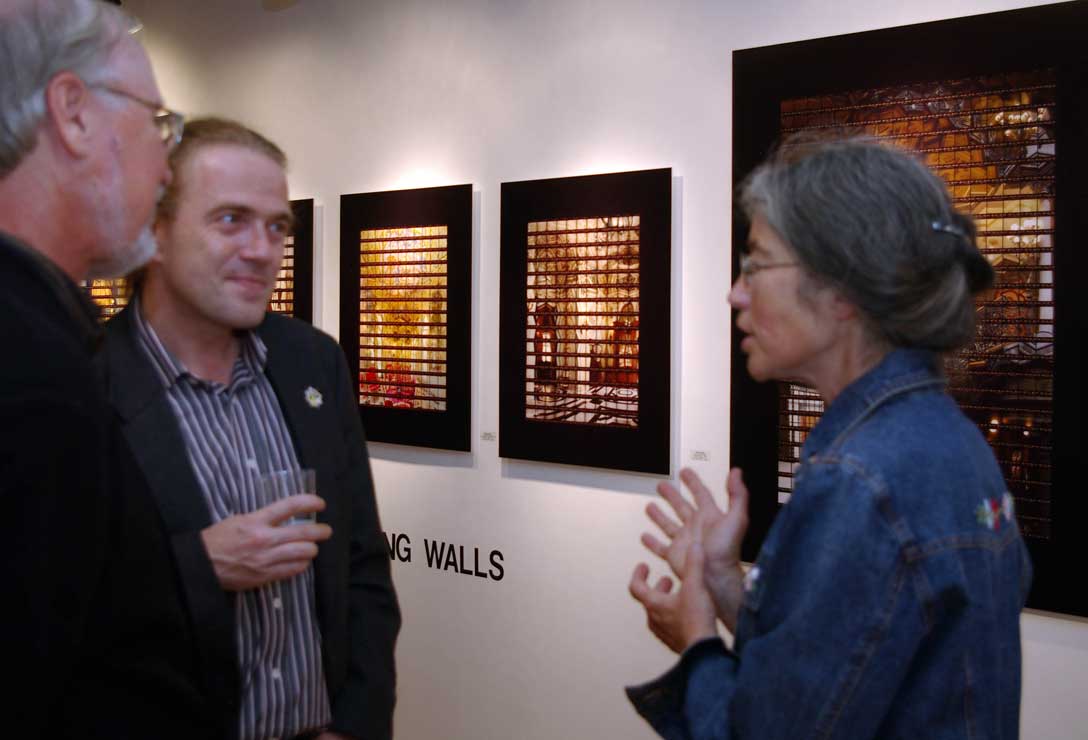Dancing Walls in the USA
September 9: Chicago. Last Friday, the exhibition Dancing Walls by Thomas Kellner opened at Schneider Gallery in Chicago. The exhibition tour began back in January at Siegen local Art Galerie and has so far included stops in Munich, Saarbrücken and Houston.
To kick off the season, all galleries in Chicago opened simultaneously on September 5. Shuttle buses drove the numerous visitors to the various gallery districts. Martha Schneider is one of the gallery owners whom the german fine art photographer met at FotoFest Houston in 2002 and who is still one of his most important supporters in the USA. Both were particularly pleased about the visit of David Travis, who until a few months ago was curator at the Art Institute and acquired several works by the artist for the collection of one of the most important museums in the USA.
One of the works was shown until last weekend in the exhibition "Mind at Play" in direct proximity to the work of David Hockney.
The exhibition Dancing Walls runs in the third biggest city until October 23 and will be on view at the in focus Galerie in Cologne from the beginning of November.
Prominent visitors for Dancing Walls
The first exhibit from the work complex Dancing Walls is the programmatic piece “British Museum, 2005”, which ingeniously transforms the architectural language of the “Great Court British Museum” project by the famous British architect Norman Foster into a kaleidoscopically arranged composition of dissected parts. Further highlights of the work complex are the series of radiantly luxuriant and golden interior views of the Genovese Pallazzi from 2005, which pars pro toto create an image of the city as a whole, and the series “Hearst Tower, 2006”, which not only reflects the architectural language of that building’s exterior. A further central piece, created in 2006, is the photography “Mexico Munal”, an additional inner view of a city’s landmark, but also plays with a traditional metaphor in its motive of a staircase.
In “Dancing Walls”, as well as in his continued earlier, open-ended series “Tango Metropolis”, Thomas Kellner joins the ranks of photography history with his extraordinarily unique photographic method, which is based on his former experiments with the pinhole camera. Kellner records the architectural monuments with his camera in a way analogous to the natural process of seeing. The thus created series of single shots from a slightly slanted perspective are subsequently construed into a new picture.
With subversive irony Thomas Kellner’s architectural photographs do not appear as the postcardesque pictures of iconic monuments we carry in our minds, nor can they be seen as images documenting these monuments’ perfect form. His buildings do not appear consolidated, much rather deconstructed into multiple fragments and reconstructed to assume an entirely new form. However, the ostensible interpretation of Kellner’s work as being cubistic-fragmentarian montages is too narrow. In fact, his art explores the history of the photography genre in a media-reflective way. Its essence lies within the fact that his large-scale color photographies are contact sheets composed of consecutively assembled filmstrips of a single shooting session. Specific pieces in “Dancing Walls” are made up of up to nine hundred shots, which translates into twenty-five rolls of film. This implies that the conceptual process begins far before the camera is actually implemented: the fragmentation of the image initially takes place within the artist’s mind. The end result amply reveals the photographic process, and even more so, it transcends the medium of photography to fundamentally argue in inter-media terms, in the dimension of the film:
“The vocabulary shared by the contact sheet, the zootrope and the motion picture is a simple assembly of images arranged one after the other in the order in which they were made, so that frozen moments in time are used to delineate space. We think of Edweard Muybridge, whose elaborate use of serial trip wires showed us the precise component movements of a horse’s streamlined gallop, or of the stilled beat of the hummingbird’s wing revealed by the stroboscopic experiments of Harold Edgerton. We are reminded that more and more of the newspaper photographs we consume are images sliced out of videotaped continuity. Kellner’s development of this working method shows an awareness of his medium’s past and present. It is self-reflexive, like so much contemporary art. It is even somewhat ironic in its choice of grand subject.” (Alison Nordström, former Curator of Photographs, George Eastman House International Museum of Photography and Film, Rochester, New York, from the exhibition catalog Thomas Kellner: Dancing Walls)
I hope these were useful Information about Dancing Walls
Sign up for the Newsletter









